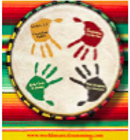Curriculum Objectives
Upon completion of the curriculum, students in the music classroom and/or community setting will:
Communicate better with their fellow students and others by having learned:
how to listen to others,
respect for the need of others to have their own musical and personal space,
the importance of leaving spaces (silence) for others to drum (speak),
how to lead and how to follow (solo and back– up).
Understand and demonstrate the value and techniques of cooperative teamwork.
Demonstrate techniques for playing various types of drums and other percussion equipment.
Sing songs with percussion and other instruments from various multicultural traditions.
Improvise new drumming ensemble patterns which are complementary to those played by other students.
Move to music while singing or playing instruments.
Create (with a small group of fellow students) new drum ensembles in the style of various drumming traditions.
Listen actively and critically to various styles of music which include percussion. While listening, students will:
echo drum patterns played by others
identify the type of instruments being played
recognize and label styles of music
identify the probable culture from which the music comes.
Understand and place greater value on the peoples and musical cultures of Africa and the Caribbean. Students will:
describe the way drumming is done in at least two contrasting traditions
discuss how traditional drumming may be the same or different from contemporary styles in various cultures
have greater respect for the people represented by the traditions studied.
Understand how music reflects similar cultural themes and patterns found in art, dance, literature, social patterns, work, etc. of the cultures studied
ORDER THE 20th ANNIVERSARY EDITION OF THE WORLD MUSIC DRUMMING CURRICULUM from West Music (apply PROMO Code: WMDCURR24 at check out).


